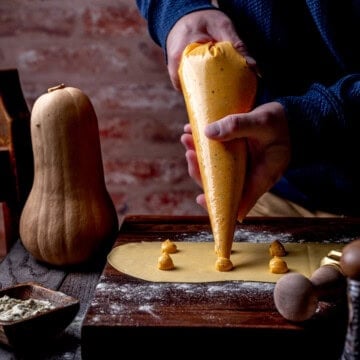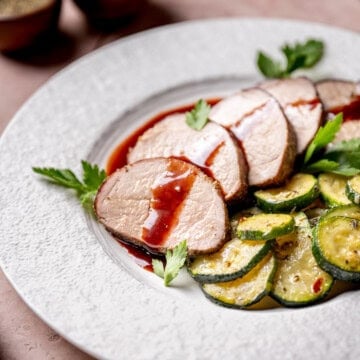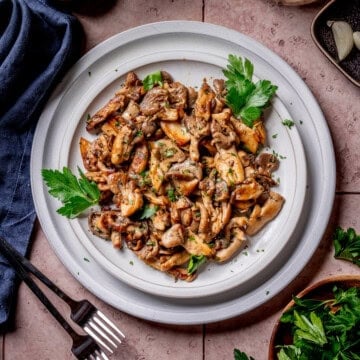Fall is pretty much here! If you live in the center of the United States and have experienced the 2022 convection oven that has been the weather, then you are more than relieved like us! To ring in fall and all that entails (football season, better weather, sweatshirts, gathering with family) we have a great way to elevate a pork tenderloin for a holiday meal, Sunday dinner or a variety of special occasions. Honestly, this recipe is a great option any night of the week as well! This relatively inexpensive cut of meat can be somewhat bland and boring on its own and because it is a lean meat, it can dry out easily. It is like a boneless, skinless chicken breast in that way. Taking that into consideration, we have a great recipe for Herb Crusted Pork Tenderloin that is a snap to prepare and will easily conquer the issue of dry, boring “other white meat” dishes that we have all come to know and dislike!

Why dry brine pork?
Let’s talk about the dry brine of the pork and the mustard rub. Yes, there is a little advanced planning involved in this dish, but it is well worth the time as there is minimal effort involved. and is the best way to achieve a nice juicy pork loin.
When you season pork with salt and pepper, resting of the pork uncovered in the fridge will essentially brine the meat. This will keep the moisture in the pork during roasting.
The second rest period is with the mustard and fresh herbs. Doing this will dry out the mustard a bit and allow it to adhere better to the pork during cooking. The mustard is not very assertive at all, so don’t feel like this is a mustard-forward dish, because it is not!
There is plenty of science behind this technique but suffice to say it is worth doing. Even if you rest for less time, it is still going to produce a more tender, juicy, and flavorful pork loin.

Can I skip the dry brine?
Yes, it will work, but it just won’t be as good with a tendency to dry out! The dry brine process helps keep the tenderloin juicy when roasting and keeps the herb rub in place by removing excess moisture. So we highly recommend doing a dry brine as instructed in the recipe for the best pork tenderloin!
Juniper Red Wine Sauce
Finally, we have the beautiful sauce for this pork tenderloin recipe! We love sauces and this one is a perfect complement to the dish. This is mostly a wine reduction finished with some butter for color, richness, flavor, and sheen.
The juniper, which is a natural flavor pairing with pork, rosemary, and sage, adds some additional flavor to the sauce.
What to Serve with Herb Roasted Pork Tenderloin
The options for side dishes here are so wide ranging that you really can’t go wrong! But we love our spicy butternut squash puree (coming soon!) and some sautéed spinach. You can also serve this with Parmesan Peppercorn Mashed Potatoes or Barley Pilaf.
Pork Recipes
If you are interested in more pork and pork loin recipes, check out our Spinach and Sun Dried Tomato Pesto Stuffed Pork Tenderloin, Stewed Spiced Pork with Cinnamon Rice or Elevated Pork Chops and Fennel Applesauce.
Enjoy!
We hope that you enjoy this recipe for this delicious Herb Crusted Pork Tenderloin with Juniper Red Wine Sauce. If you give this recipe a try and like it, leave us a 5 star rating and comment below, or tag us on Instagram @cooking_with_wine!

Looking for more recipes like this? Check these out:
- Garlic Thyme Studded Beef Tenderloin Roast with Red Wine Sauce
- Sage Prosciutto and Gruyere Chicken Roulade
- Pan Seared Duck with Cherry Port Sauce
- Peppercorn Crusted Steak with Brandy Cream Sauce
📖 Recipe

Herb Crusted Pork Tenderloin with Juniper Red Wine Sauce
Ingredients
For the Pork
- 2 lb pork tenderloin, trimmed (2 small pork tenderloins)
- 2 teaspoon kosher salt
- ½ teaspoon black pepper
- ¼ cup Dijon mustard
- 1 tablespoon + 1 teaspoon fresh sage, finely chopped
- 1 tablespoon + 1 teaspoon fresh rosemary, finely chopped
- ½ teaspoon dried ginger
For the Sauce
- 2 teaspoon olive oil
- 1 medium shallot – finely chopped
- 1 cup dry red wine
- ½ cup tawny port
- 6 black peppercorns
- 8 juniper berries
- 6 tablespoon cold unsalted butter – cubed
- Kosher salt to taste
Instructions
Dry Brine the Pork
- To dry brine the pork, first dry the trimmed pork tenderloin thoroughly. Sprinkle the meat on all sides with the salt and pepper and place pork on a wire rack over a roasting pan. Refrigerate uncovered for 3 hours.
- After 3 hours, mix the mustard, sage, rosemary, and dried ginger together in a small bowl. Remove the pork from the refrigerator and coat with the herb mixture. Return the pork to the rack and refrigerate for another hour (or up to several hours).
Roast the Pork
- Preheat the oven to 425°F.
- Remove the roasting pan with the pork from the refrigerator 30 minutes and let it sit at room temperature before putting it in the oven. Once the oven is up to temp, place the roasting pan in the hot oven and cook the pork loin until the internal temperature reaches 145°F on a meat thermometer. This will take about 25-35 minutes. The cooking time will depend on the thickness of the meat, so we highly recommend using an instant-read thermometer to make sure it is cooked properly. Let the pork rest for 7-10 minutes before slicing.
Prepare the Sauce
- While the pork is roasting, heat the olive oil in a saucepan over medium heat. Add the shallots and cook until they just start to brown.
- Gently crack the juniper berries by smashing them with the flat side of the blade of a kitchen knife. Don’t crush them completely, just crack them a bit so they can release their flavor. Add the wine, port, peppercorns, and juniper berries to the pan and bring to a simmer. Turn the heat down slightly and reduce the liquid by half.
- Once reduced, strain the mixture and discard the solids. Return the liquid to the saucepan and reduce until you have about 6 tablespoons of liquid remaining. Up to this point, you can make this part of the sauce in advance if desired, just reheat gently before moving to the next step.
- While the pork roast rests on a cutting board, remove the reduced sauce from the heat and whisk in the butter one cube at a time until fully incorporated. If the sauce is not warm enough to melt the butter you can return to a low heat, but do not use high heat or bring the sauce to a boil. This is more of a reduction sauce mounted with butter than a butter sauce, so it is less delicate and somewhat thinner than a butter sauce.
- Taste and adjust the amount of salt if needed and serve the sauce over your sliced pork tenderloin. Enjoy!
Nutrition
Do you love our recipes?
We work hard to provide you with delicious FREE recipes here on Cooking With Wine. If you love and value our content and want to support our efforts, you can contribute whatever amount you are comfortable with below.
Buy me a coffeeWe will continue to provide you with recipes no matter what, so there is no obligation to contribute! Any and all contributions are greatly appreciated!
Thank you for being part of our community! You are the reason we do what we do!





Leave a Reply